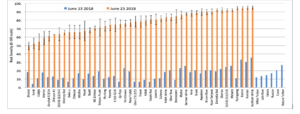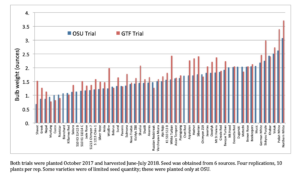Final report for OW17-024
Project Information
Garlic is an important crop for organic vegetable growers and small seed companies in Oregon and California. Some farmers increase economic value by processing garlic into braids, pestos, powders and salts. Garlic grows during Oregon’s wet season (planted October, harvested July) so is a crop that can be grown even with increasingly scarce late season water availability. If organic garlic is to increase its market share, garlic varieties suited to this region with resistance/resilience to garlic rust and other diseases and problems must be identified. Garlic rust became a significant problem in California in 1998, reducing yields by up to 50% and soluble solids by 15%. California organic farms control rust through spatial rotation, sanitation, and marginally effective sulfur applications; rust reduces yields there by 25-50%. Rust was sporadic in Oregon before 2010 but now reduces yields by up to 40%. Fusarium basal rot is a significant disease in California. While less important in cooler Oregon, 10-20% damage was observed in Oregon fields in 2014 and 2015.
Seed savers, garlic farmers, and garlic seed producers (Garlicana and Deerfield Farm) have been evaluating garlic germplasm in this region. While garlic primarily reproduces clonally/asexually, some types reproduce sexually (true seed); Garlicana and Deerfield have been growing and selecting garlic from true seed for regional performance but not disease resistance. Variety trials were conducted in CA in the 1990s to identify rust resistant garlic varieties but no significant resistance was identified in the varieties tested. Research in Spain and Colorado identified rust resistance and Wisconsin research identified Fusarium basal rot resistance in USDA NPGS garlic germplasm; rust resistance was identified in varieties derived from seed of NPGS germplasm.
The goals of this project are to:
1: Identify and collect garlic varieties/germplasm with organic market, disease resistance, and storage potential
2: Engage farmers, seed growers, and buyers in the development of garlic evaluation criteria for diverse uses and markets
3: Screen garlic varieties/germplasm for disease resistance and other evaluation criteria developed in Objective 2.
4: Engage organic garlic growers and buyers in project findings.
Seed stock of at least 100 garlic varieties/accessions will be accessed from: USDA NPGS (National Plant Germplasm System); Deerfield Farm (tissue-culture); Garlicana (clonal and true-seed); Other seed/farm sources; and Seed Savers Exchange. Through discussions at meeting one (and pre-meeting surveys of farmers and buyers), garlic uses, markets, and evaluation criteria will be described.
Varieties will be evaluated in replicated experiments in one location in California and two locations in western Oregon. Disease severity and other measurements/photos will be taken as determined by the evaluation criteria. Bulbs and cloves will be weighed and photographed. Garlic will be stored and percent rotten, sprouted, and desiccated bulbs will be evaluated monthly.
Project farmers will interact with and taste garlic and discuss project findings at winter meetings. Other farmers/buyers will interact with varieties and learn about results through booths, tastings, presentations and workshops, and an article describing garlic varieties.
We anticipate that farmers will increase their understanding of garlic varieties and their uses, markets and performance, as well as their knowledge of garlic problems and their management. They will adopt new garlic cultivars to improve performance and/or add uses/markets.
Objective 1: Identify and collect garlic varieties/germplasm with organic market, disease resistance, and storage potential
Objective 2: Engage farmers, seed growers, and buyers in the development of garlic evaluation criteria for diverse uses and markets
Objective 3: Screen garlic varieties/germplasm for disease resistance and other evaluation criteria developed in Objective 2.
Objective 4: Engage organic garlic growers and buyers in project findings.
Cooperators
- (Researcher)
- (Educator)
Research
Garlic seed was accessed from multiple sources including commercial garlic seed sources (49 accessions) and the USDA Germplasm Repository in Pullman, WA (90 accessions).
Four replicated trials of the 49 commercial accessions (4 replications, at least 6 plants per replication) were established in October 2017 at 1) the OSU Vegetable Research Farm in Corvallis, OR, 2) Phil Foster Ranch in Hollister, CA, 3) Gathering Together Farm in Philomath, OR, and 4) White Oak Farm in Albany, OR. The 90 USDA accessions were grown up at the OSU Vegetable Reesarch farm for planting in replicated trials in 2018-19.
In 2018, all 49 commercial accessions and 90 USDA accessions were planted in replicated trials in 3 locations: 1) the OSU Vegetable Research Farm in Corvallis, OR, 2) Gathering Together Farm in Philomath, OR (for rust evaluation), and 4) White Oak Farm in Albany, OR (for white rot evaluation).
In 2019, commercial and USDA accessions were planted at 1) the OSU Vegetable Research Farm in Corvallis, OR, and 2) Gathering Together Farm in Philomath, OR, and 3) White Oak Farm in Albany, OR
2018
Rust incidence was extremely low at Phil Foster Ranch so there were no significant differences in rust in that trial. Rust severity was moderate at Gathering Together Farm. White Turban, Jade Rose, Sakura, Russian White, and Cuzco matured and were harvested early, thereby escaping severe rust damage. Rust severity in Shvelisi, Surak, Kishlyk and Anarres (varieties of lowest severity) was significantly lower than in Pyongyang, Hadrut, Navistar, and Northern White (varieties of highest severity).

Unexpectedly, there was white rot in the trial at White Oak Farm. Even more unexpectedly, while most plants were killed by the white rot fungus, all plants of one variety (Khabar) survived.
In both the OSU and GTF trials there were significant differences in bulb size. The varieties with the largest bulbs were Donastia Red, Duganski, Metechi, Brown Rose, Beekeeper's Sicilian, Music, German White, Siskiyou Purple, Khabar, Vekak, Polish White, and Northern White.

Varieties also varied in cloves per bulb and clove size. Cloveweightnumber
2019
Rust incidence was moderate at Gathering Together Farm. However, there was no significant difference in rust severity amongst the commercial or USDA accessions. The average number of plantable cloves per pound (important for garlic production profitability) varied considerably, as did the proportion of bulbs with severe eriophyid mite damage.
Clovesperpoundandmitedamagetable
In an unreplicated trial at Phil Foster Ranch, Kishlyk and Shvelisi exhibited lower rust severity than other varieties, including Creole Red and Early CA White (see photo by Doug O'Brien); these two varieties also exhibited low rust severity in 2018 Oregon trials.
In the replicated trial at White Oak Farm, where the soil is evenly infested with Sclerotium cepivorum propagules, all plants of Khabar and German White survived, while all plants of other accessions did not.
Research Outcomes
Education and Outreach
Participation Summary:
In December 2018 a full day workshop was held. Ten garlic seed growers, 6 garlic farmers, and 10 agricultural professionals attended. Topics addressed included disease and insect pest diagnosis and management, results from variety trials, and differences in garlic type quality, storage and uses. Participants observed garlic mites through a high powered dissecting scope.
In preparation for the workshop, a draft of a publication on garlic types and uses was developed and distributed at the workshop. This publication, Garlic Types and Market Niches, was further developed and published in 2020 and is available at https://www.eatwintervegetables.com/garlic-zine
As the result of the December 2018 workshop, a group of garlic farmers and seed companies, with support from this project and Stone, is developing the Cascadia West Garlic Growers Association https://cascadiagarlic.org, the purpose of which is to bring together garlic farmers and garlic seed growers to learn together and improve garlic seed quality in Oregon and Washington. The leadership team includes Garlicana, Adaptive Seed, and Fiddlehead Farm.
This project and the CGSA staffed a garlic table at the Winter Vegetable Sagra in December 2019 https://www.eatwintervegetables.com/winter-vegetable-sagra and created the garlic content at https://www.eatwintervegetables.com/the-vegetables.
A virtual garlic festival was coordinated in December 2020. All presentations were streamed live and archived at https://www.youtube.com/c/culinarybreedingnetwork
November 30th - 4th, 2020: Garlic Sagra (festival)
11/30: Phil Simon of USDA-ARS discussed garlic history and his garlic collecting expeditions in Central Asia, where wild garlic still exists in "Garlic in History, and History in Garlic: Diversity & Domestication”
12/1: Avram Drucker of Garlicana shared his personal journey of becoming a garlic breeder, garlic types, and his breeding program.
12/2: Linda McLean of WSU Colville Reservation Extension discussed the Inchelium Red Garlic project which connects youth with knowledgeable elders to learn about traditional cultural foods and harvesting & preparation practices.
12/3: Barbara Hellier of USDA-ARS discussed genetic diversity and her role as curator of the National Plant Germplasm System’s Allium Collection.
12/4: Irwin Goldman of University of Wisconsin discussed medicinal properties of garlic in "Garlic is Better than Ten Mothers: An Exploration of Health Benefits"
12/4: Mary DeLorenzo-Woods, folk herbalist, discussed garlic folklore.
Education and Outreach Outcomes
Eriophyid mites were identified as the most critical pest problem in Pacific Northwest garlic production; organic strategies to control this pest are a critical research need.